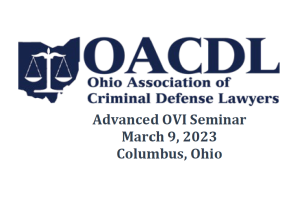 The annual ‘Advanced OVI Seminar’, presented by the Ohio Association of Criminal Defense Lawyers (OACDL), was held last week in Columbus. As usual, the seminar featured outstanding speakers from Ohio and across the continent. As always, the speakers delivered valuable information to help DUI lawyers (called ‘OVI’ lawyers in Ohio) improve their skills.
The annual ‘Advanced OVI Seminar’, presented by the Ohio Association of Criminal Defense Lawyers (OACDL), was held last week in Columbus. As usual, the seminar featured outstanding speakers from Ohio and across the continent. As always, the speakers delivered valuable information to help DUI lawyers (called ‘OVI’ lawyers in Ohio) improve their skills.
New Regulations for Alcohol and Drug Testing
A hot topic among OVI defense attorneys in Ohio is the new rules for alcohol and drug testing. These Ohio Department of Health regulations became effective on January 23, 2023 and were the subject of a previous article in this blog. Attorney Blaise Katter, the Public Policy Director for the Ohio Association of Criminal Defense Lawyers, did an excellent job of highlighting the changes. Katter also provided a behind-the-scenes look at the creation of the regulations, which were drafted in 2018 but not introduced for public comment until 2022.
One conspicuous addition to the regulations is oral fluid testing. Previously, Ohio law authorized testing blood, urine, and breath. The new regulations add oral fluid to the bodily substances which may be tested. Dominy Law Firm attorney Bryan Hawkins gave a presentation about the dubious science behind oral fluid testing and explained how oral fluid is particularly ineffective for testing THC, the drug most commonly suspected in OVI cases. Canadian attorneys Kyla Lee and Paul Doroshenko then provided a live demonstration of the new testing method.
Trial Techniques
Trial techniques is not a new topic like the revised regulations, but it is an important one, and it was addressed by multiple speakers. Terry Rudes gave a presentation on attacking the breath test at trial, and Andy Bucher explained how he cross-examines officers at trial about field sobriety tests.
Cross-examination is what OVI defense lawyers do most in trials. Three presentations at the seminar addressed three cross-examination methods. Florida attorneys Michael Kessler and Keeley Karatinos discussed the McCarthy cross, which tells a story with short yes-or-no questions. Charles Rathburn and Tim Huey demonstrated the Posner-Dodd method, which is similar to the McCarthy cross but divided into chapters. A contrasting method was presented by New York attorney Eric Sills, who explained the benefits of cross-examining witnesses with open-ended questions. All three methods have benefits, and a lawyer can mix-and-match the techniques in the context of one cross-examination.
For many lawyers, the most challenging phase of a trial is jury selection (voir dire). Texas attorney Deandra Grant explained her ‘Team Innocent’ voir dire. After jurors discuss how difficult it would be to convince them to switch jerseys from their favorite sport team, she explains the presumption of innocence places them on Team Innocent. The jurors realize it would take a lot of evidence, proof beyond a reasonable doubt, to convince them to ‘switch jerseys’ to Guilty. Grant has described this voir dire method previously, and Ohio attorneys have successfully implemented it in OVI trials.
‘Veteran’ Lawyers
Two presentations were given by ‘veteran DUI lawyers’. Hopefully, ‘veteran’ isn’t code for ‘old’, as I participated in one of the presentations. First, Cincinnati attorney Kelly Farrish revealed “Kelly’s Nuggets”, mined from his 43-year career. Then, I presented with attorneys Jon Saia and Rob Calesaric (who are both older than me, and I have been practicing 25 years!). There were several presentations on trial techniques, and there was a trial skills workshop on Saturday, so we focused on preparing for hearings on motions to suppress evidence. The topic of hearing preparation is not as sexy as trial execution, but thorough preparation is critical to polished execution.
Even after 25 years of practice and dozens of trials, I learned from the presentations at this seminar. It was an honor to be a speaker in the company of outstanding lawyers from across North America.
 Columbus OVI/DUI Attorney Blog
Columbus OVI/DUI Attorney Blog

